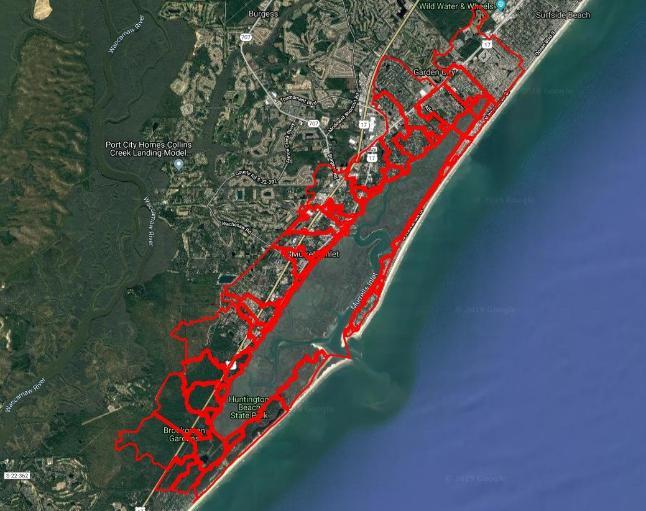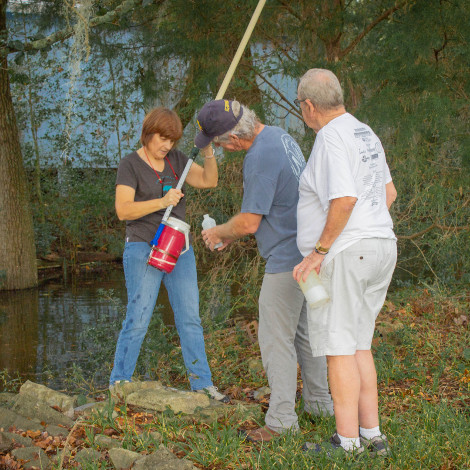Murrells Inlet Watershed Planning
Introduction
This web page describes a community-bsaed effort to protect and improvement shellfish beds in Murrells Inlet. The primary concern has been to re-open shellfish beds that have been closed due to fecal bacteria pollution. The story begins in the 1970's with the advent of regulatory monitoring for fecal bacteria in the waters of Murrells Inlet. To summarize all the efforts to date a historical timeline presented. Most recently a watershed-based plan has been developed, approved by SC DHEC and is in the process of being implemented. The details of this latest effort are also presented.
Murrells Inlet is a Watershed
The Murrells Inlet watershed is located in the Long Bay region of South Carolina and drains into the Atlantic Ocean. The estuary contains high-salinity seawater, which creates an ideal habitat for shellfish. The estuary’s high biological productivity supports the Murrells Inlet local economy, which is centered around coastal tourism. However, high fecal bacteria contamination has threatened the shellfish industry due to closures of important oyster beds. A watershed-based plan has been put into action to reduce fecal bacteria pollution.

Map of Murrells Inlet showing subwatershed boundaries in red.
Timeline of Water Quality Story in Murrells Inlet
1970s - South Carolina Health and Environmental Control (SC DHEC) regularly found high levels of fecal bacteria during routine shellfish sampling. This sampling was part of the National Shellfish Sanitation Program. The high levels of fecal bacteria pollution led to closure of the contaminated shellfish beds. This is recorded in the annual shellfish management reports for Area 04.
1980s - The contaminated waters in Murrells Inlet were added to the Clean Water Act's Federal List of Impaired Waters, known as the 303(d) list. A Total Maximum Daily Load, or TMDL, was required to be performed to identify how much of a reduction of the pollutant would need to be achieved for the impaired waters to come into compliance with federal regulation.
2005 - The TMDL was approved by SC DHEC. It showed that an 80% reduction of the fecal bacteria pollution was needed to meet regulation. It didn't, however, identify where in the landscape the fecal bacteria pollution was come from. The final report suggested monitoring should be continued.
2007 - SC DHEC Ocean Coastal Resource Management (OCRM) developed a Special Area Management Plan (not finalized) to remediate the waters. During this time the EQL performed the first measurements in upland streams and found the fecal bacteria pollution.
2008 - Murrells Inlet 2020 in conjuction with Cosatal Carolina University's Waccamaw Watershed Academy develop the first volunteer water quality monitoring program in Murrells Inlet.
2014 - SC DHEC Bureau of Water funded development of a watershed-based plan. This was approved by SC DHEC. Remediation efforts began with the installation of the first best management practices (BMPs) funded by a USEPA Section 319 grant.
2014 - 2017 - Microbial source tracking was performed by Coastal Carolina University's Environmental Quality Lab to identify geographic and host animal sources.
2017 - They started the assessment of the BMPs to determine effectiveness. They also sought to identify new BMPs to be implimented at other sites.
Watershed-based plan
Click here to read the plan that was approved by SC DHEC in 2014.
Why the plan was developed
- To remediate long standing fecal bacteria pollution causing shellfish bed closures.
- Required by SC DHEC TMDL issued in 2005
- To address land-based sources of fecal bacteria identified by the Volunteer water quality monitoring program that was started in 2008.
Who developed the plan and who is implementing it
- Waccamaw Regional Council of Government
- Murrells Inlet 2020
- Horry County Stormwater
- Georgetown County Stormwater
- Waccamaw Watershed Academy
- South Carolina Department of Health and Environmental Control watershed
For more details about these events, explore the stories and video posted below.
For more information contact Murrells Inlet 2020






